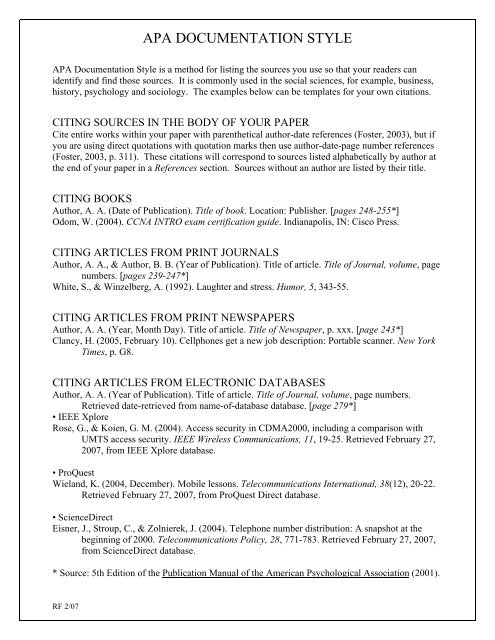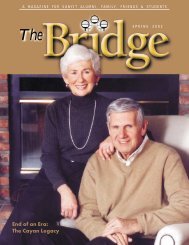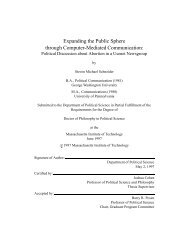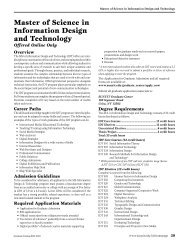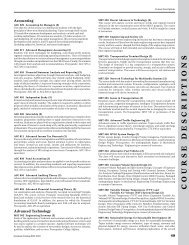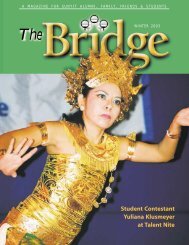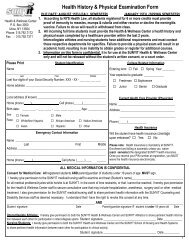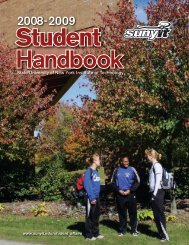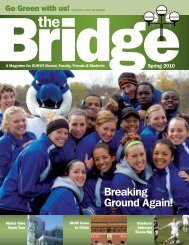APA Documentation Style is a method for listing the sources you use ...
APA Documentation Style is a method for listing the sources you use ...
APA Documentation Style is a method for listing the sources you use ...
Create successful ePaper yourself
Turn your PDF publications into a flip-book with our unique Google optimized e-Paper software.
<strong>APA</strong> DOCUMENTATION STYLE<br />
<strong>APA</strong> <strong>Documentation</strong> <strong>Style</strong> <strong>is</strong> a <strong>method</strong> <strong>for</strong> l<strong>is</strong>ting <strong>the</strong> <strong>sources</strong> <strong>you</strong> <strong>use</strong> so that <strong>you</strong>r readers can<br />
identify and find those <strong>sources</strong>. It <strong>is</strong> commonly <strong>use</strong>d in <strong>the</strong> social sciences, <strong>for</strong> example, business,<br />
h<strong>is</strong>tory, psychology and sociology. The examples below can be templates <strong>for</strong> <strong>you</strong>r own citations.<br />
CITING SOURCES IN THE BODY OF YOUR PAPER<br />
Cite entire works within <strong>you</strong>r paper with paren<strong>the</strong>tical author-date references (Foster, 2003), but if<br />
<strong>you</strong> are using direct quotations with quotation marks <strong>the</strong>n <strong>use</strong> author-date-page number references<br />
(Foster, 2003, p. 311). These citations will correspond to <strong>sources</strong> l<strong>is</strong>ted alphabetically by author at<br />
<strong>the</strong> end of <strong>you</strong>r paper in a References section. Sources without an author are l<strong>is</strong>ted by <strong>the</strong>ir title.<br />
CITING BOOKS<br />
Author, A. A. (Date of Publication). Title of book. Location: Publ<strong>is</strong>her. [pages 248-255*]<br />
Odom, W. (2004). CCNA INTRO exam certification guide. Indianapol<strong>is</strong>, IN: C<strong>is</strong>co Press.<br />
CITING ARTICLES FROM PRINT JOURNALS<br />
Author, A. A., & Author, B. B. (Year of Publication). Title of article. Title of Journal, volume, page<br />
numbers. [pages 239-247*]<br />
White, S., & Winzelberg, A. (1992). Laughter and stress. Humor, 5, 343-55.<br />
CITING ARTICLES FROM PRINT NEWSPAPERS<br />
Author, A. A. (Year, Month Day). Title of article. Title of Newspaper, p. xxx. [page 243*]<br />
Clancy, H. (2005, February 10). Cellphones get a new job description: Portable scanner. New York<br />
Times, p. G8.<br />
CITING ARTICLES FROM ELECTRONIC DATABASES<br />
Author, A. A. (Year of Publication). Title of article. Title of Journal, volume, page numbers.<br />
Retrieved date-retrieved from name-of-database database. [page 279*]<br />
• IEEE Xplore<br />
Rose, G., & Koien, G. M. (2004). Access security in CDMA2000, including a compar<strong>is</strong>on with<br />
UMTS access security. IEEE Wireless Communications, 11, 19-25. Retrieved February 27,<br />
2007, from IEEE Xplore database.<br />
• ProQuest<br />
Wieland, K. (2004, December). Mobile lessons. Telecommunications International, 38(12), 20-22.<br />
Retrieved February 27, 2007, from ProQuest Direct database.<br />
• ScienceDirect<br />
E<strong>is</strong>ner, J., Stroup, C., & Zolnierek, J. (2004). Telephone number d<strong>is</strong>tribution: A snapshot at <strong>the</strong><br />
beginning of 2000. Telecommunications Policy, 28, 771-783. Retrieved February 27, 2007,<br />
from ScienceDirect database.<br />
* Source: 5th Edition of <strong>the</strong> Publication Manual of <strong>the</strong> American Psychological Association (2001).<br />
RF 2/07
<strong>APA</strong> DOCUMENTATION STYLE<br />
CITING WEB SITES<br />
Rules:<br />
1. For works with no author, move <strong>the</strong> title to <strong>the</strong> author position (be<strong>for</strong>e <strong>the</strong> date of publication).<br />
2. Capitalize only <strong>the</strong> first word of <strong>the</strong> title and of <strong>the</strong> subtitle, if any, and any proper nouns. Do not<br />
place quotation marks around <strong>the</strong> title. Put <strong>the</strong> title in italics.<br />
3. Use (n.d.). when a source does not have a date.<br />
4. Provide <strong>the</strong> document's Internet address at <strong>the</strong> end of <strong>the</strong> retrieval statement. Direct readers as<br />
closely as possible to <strong>the</strong> in<strong>for</strong>mation being cited. Whenever possible reference specific documents<br />
ra<strong>the</strong>r than home or menu pages. Provide address that work.<br />
5. When an Internet document compr<strong>is</strong>es multiple pages, i.e., different sections have different<br />
URLs, provide a URL that links to its home page.<br />
6. Do not insert a hyphen if <strong>you</strong> need to break a URL across lines. Instead, break <strong>the</strong> URL after a<br />
slash or be<strong>for</strong>e a period. Fin<strong>is</strong>h <strong>the</strong> citation with a period unless it ends with an Internet address.<br />
7. At a minimum, a reference to an Internet source should provide a document title or description, a<br />
date -- ei<strong>the</strong>r <strong>the</strong> date of publication or update or <strong>the</strong> date of retrieval -- and web site address.<br />
Whenever possible identify <strong>the</strong> authors of a document as well.<br />
• Example A: The Generic Entry [page 231*]<br />
Electronic reference <strong>for</strong>mats recommended by <strong>the</strong> American Psychological Association. (2000,<br />
October 12). Retrieved February 27, 2007, from http://www.apa.org/journals/webref.html<br />
• Example B: Internet Article Based On A Print Source [page 271*]<br />
VandenBos, G., Knapp, S., & Doe, J. (2001). Role of reference elements in <strong>the</strong> selection of<br />
re<strong>sources</strong> by psychology undergraduates [Electronic version]. Journal of Bibliographic<br />
Research, 5, 117-123.<br />
• Example C: Multipage Document Created By A Private Organization, No Date [page 273*]<br />
Greater New Mil<strong>for</strong>d (Ct) Area Healthy Community 2000, Task Force on Teen and Adolescent<br />
Issues. (n.d.). Who has time <strong>for</strong> a family meal? You do! Retrieved February 27, 2007, from<br />
http://www.familymealtime.org<br />
• Example D: Stand-alone Document, No Author Identified, No Date [page 274*]<br />
GVU’s 8th WWW <strong>use</strong>r survey. (n.d.). Retrieved February 27, 2007, from http://www.cc.gatech.edu/<br />
gvu/<strong>use</strong>r_surveys/survey-1997-10/<br />
• Example E: Report From A Private Organization, Available On Its Web Site [page 275*]<br />
Canarie, Inc. (1997, September 27). Towards a Canadian health IWAY: V<strong>is</strong>ion, opportunities and<br />
future steps. Retrieved February 27, 2007, from http://www.canarie.ca/press/publications/<br />
pdf/health/healthv<strong>is</strong>ion.doc<br />
* In<strong>for</strong>mation on citing web sites <strong>is</strong> taken from pages 268-281 of <strong>the</strong> Publication Manual of <strong>the</strong><br />
American Psychological Association.<br />
RF 2/07


